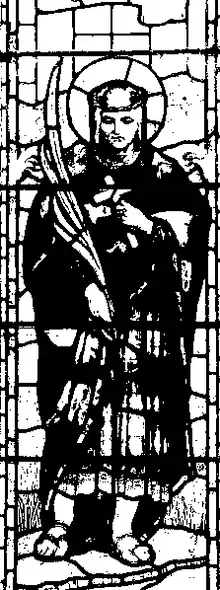Cynog ap Brychan
Cynog son of Brychan (Welsh: Cynog ap Brychan; born c. 434), better known as Saint Cynog (Old Welsh: Kennauc), was an early Welsh saint and martyr. His shrine is at Merthyr Cynog in Wales and his feast day is observed on 7[1] or 9[2] October.

Cynog was reputedly a son of Brychan, a powerful Welsh prince of the British Dark Ages. Cynog's mother was reputedly Benadulved, daughter of Benadyl, a prince of Powys, whom Brychan seduced while a hostage at the court of her father.[3]
He is said to have been murdered on the mountain called the Van (Bannau Brycheiniog). His relics are housed at Merthyr Cynog.
In 1188, Gerald of Wales wrote that there still existed a certain relic purported to be a royal torc that had once been worn by Cynog, presumably as an item of royal regalia. Gerald encountered this relic while travelling through Brycheiniog. He wrote of this relic:
Moreover I must not be silent concerning the collar which they call St. Canauc's; for it is most like to gold in weight, nature, and colour; it is in four pieces wrought round, joined together artificially, and clefted as it were in the middle, with a dog's head, the teeth standing outward; it is esteemed by the inhabitants so powerful a relic, that no man dares swear falsely when it is laid before him: it bears the marks of some severe blows, as if made with an iron hammer; for a certain man, as it is said, endeavouring to break the collar for the sake of the gold, experienced the divine vengeance, was deprived of his eyesight, and lingered the remainder of his days in darkness.
— Gerald of Wales, The Itinerary of Archbishop Baldwin through Wales, Chapter II [3]
The detailed description, which, though not easy to interpret, points, in the opinion of Sir T. D. Kendrick, to its probably being Welsh or Irish work of the Viking period, i.e. the 10th or the 11th century.[4]
He is chiefly commemorated in Brycheiniog, where Defynnog, Ystradgynlais, Penderyn, Battle, Llangynog, and Merthyr Cynog, are all named after him, the last being reputed his place of burial.[4]
References
- Moran, Patrick. Irish Saints in Great Britain. Gill (Dublin), 1879. Accessed 9 Feb 2013.
- Tristam, Simon K. Exciting Holiness. Hymns Ancient and Modern Ltd, 2007. Accessed 9 Feb 2013.
- Vision of Britain: Gerald of Wales, The Itinerary of Archbishop Baldwin through Wales, Chapter 2
- Lloyd, John Edward. "Welsh Biography Online", National Library of Wales